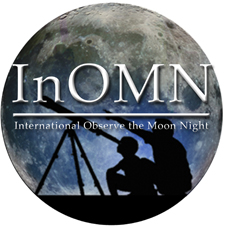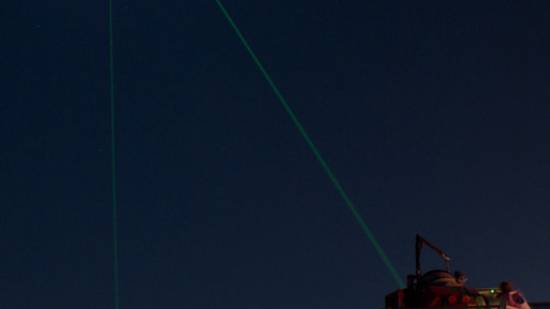NASA celebrates the moon by shooting lasers at it
Source: dvice.com

Last night was "International Observe the Moon Night," apparently, and NASA celebrated by shooting our favorite satellite with lasers. Naturally!
Don’t worry, the lasers weren’t the explodey kind, they were the observey kind. The lasers, fired from the Goddard Space Flight Center’s Laser Ranging Facility in Greenbelt, Maryland, are used to track the location of the Lunar Reconnaissance Orbiter as it orbits the moon. All NASA has to do is fire those lasers 28 times a second and they’re able to pinpoint where the SUV-sized satellite is as it moves at 3,600 MPH over 250,000 miles away. Pretty awesome.
Article from: dvice.com
"Last night was "International Observe the Moon Night", and of the 400 or so Moon-centric gatherings around the world, this one had to be the most spectacular, as NASA shot laser blasts at the Moon...for strictly scientific purposes, honest.
Don’t worry, this isn’t the opening shots in NASA’s long delayed invasion of the Moon. The laser, located at the Goddard Space Flight Center’s Laser Ranging Facility in Greenbelt, Maryland, is used to track the location of the Lunar Reconnaissance Orbiter as it moves around the Moon.
The probe is about the size of a small SUV, it’s moving at 3,600 miles per hours, and it’s located 250,000 miles away, and yet NASA can figure out exactly where it is at any given moment by firing lasers at it 28 times every second and then measuring how the focused light is reflected back to Earth.
Usually, these activities are closed to the public, but NASA allowed tourists into the facility to watch the operation as part of International Observe the Moon Night. " Source
How do you make a huge telescope even more powerful? Lasers, of course!
From: DVice.com

No, this observatory is not starting a war with a distant alien race. Instead, it’s exciting the atoms in the upper atmosphere to create an artificial star 56 miles above Earth. And this, of course, will help it take pictures of the cosmos.
The European Southern Observatory uses this method, called the Laser Guide Star, to provide a reference for the four mirror-based telescopes that make up the Very Large Telescope array.
It’s all very cool and futuristic, although part of me does wish that the laser was being used to blast some baddie’s spaceship out of the sky. Maybe someday!
Observe the Moon Night Goes Global
From: NASA.gov
 On September 18, 2010 the world will join the NASA Goddard Space Flight Center’s Visitor Center in Greenbelt, Md., as well as other NASA Centers to celebrate the first annual International Observe the Moon Night (InOMN).
On September 18, 2010 the world will join the NASA Goddard Space Flight Center’s Visitor Center in Greenbelt, Md., as well as other NASA Centers to celebrate the first annual International Observe the Moon Night (InOMN)."InOMN provides the opportunity for the general public, our partners, and amateur astronomers to learn about lunar science and to view the Moon - many for the first time - through telescopes!" said Brooke Hsu, the Education and Public Outreach lead for the Lunar Reconnaissance Orbiter (LRO) and principle investigator for InOMN.
What started as a celebration of LRO’s successful journey to orbit around the Moon last August has grown to into an astronomical event this year. After LRO’s launch, Goddard’s Education and Outreach Team hosted the event, "We’re at the Moon!" The same day, the event "National Observe the Moon Night," was hosted at NASA’s Ames Research Center (ARC) in Moffett Field, Calif. by the Lunar Crater Observation and Sensing Satellite and NASA Lunar Science Institute (NLSI) teams. NLSI is based at NASA Ames. This year, the teams have decided to expand the event by partnering with other NASA institutions, organizations and communities around the world.
"The goal of both of these events was similar: engage the local public and amateur astronomer communities in an event to raise awareness of NASA’s involvement in lunar research and exploration. The events were so successful we’ve decided to do it again. Only better and much, much bigger," said Doris Daou, the director of communications and outreach for NLSI.
The event, which is free to the public, will be from 6:30 p.m.-10:00 p.m. EDT and include guest speakers and astronomers discussing lunar science, hands-on activities using binoculars and amateur astronomy telescopes and a public unveiling of new LRO images. There will even be a number of tours to the Laser Ranging facility at the Goddard Geophysical and Astronomical Observatory and presentations on the always fascinating Science on a Sphere globe at the Visitor’s Center.
"I think it’s important to have an event like this at Goddard for two reasons. One, Goddard is leading the LRO mission to the moon, and it’s important for the public to be exposed to the amazing results of that mission. Secondly, I really like the idea of exposing the public to a diverse range of topics covered at a NASA center," said Dr. Noah Petro, a research scientist at the Goddard Planetary Geodynamics Branch.
Petro will be giving a presentation on recent lunar discoveries and discussing images of the lunar surface at the "New Light" activity station.
Also tune into:
Mike Bara - Dark Mission, The Occult NASA Moon Mission
David Wilcock - Dark Mission, 2012 & Time Cycles
Todd Campbell - Through the Looking Glass Continued
Richard C. Hoagland - Phobos an Ancient Alien Spaceship, Mars, NASA & Disclosure
Joseph P Farrell - Cosmic War, Interplanetary Warfare & Mesopotamian Mythology
Ted Twietmeyer - What NASA isn’t Telling you about Mars
Ted Twietmeyer - The Moon & Sun, Time & UFO’s






















